Solar Eclipse Magic
Air Date: Week of March 15, 2024
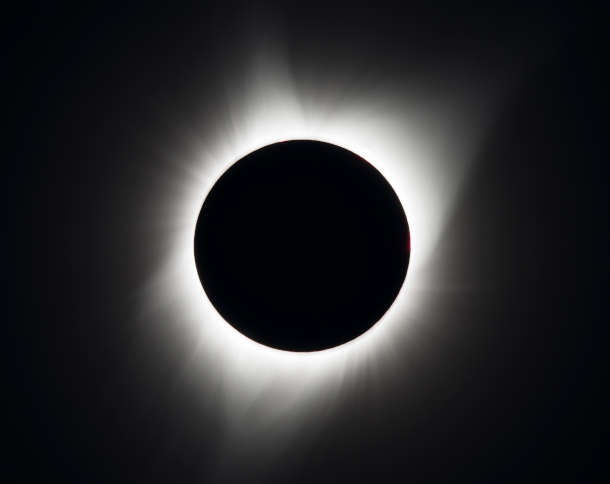
In 2017, a total solar eclipse crossed across a narrow portion of the United States from Lincoln Beach, Oregon to Charleston, South Carolina. A partial solar eclipse was visible across the entire North American continent, as well as parts of South America, Africa, and Europe. (Photo: Aubrey Gemignani, NASA, Flickr, CC BY 2.0)
On April 8th millions across North America will have the opportunity to experience a total solar eclipse, when the moon briefly blocks out the sun. Cosmologist Roberto Trotta is the author of “Starborn: How the Stars Made Us (And Who We Would Be Without Them)" and joins Host Jenni Doering to describe how our ancestors reacted to this strange, otherworldly phenomenon and how you too can safely witness it.
Transcript
O’NEILL: It’s Living on Earth, I’m Aynsley O’Neill
DOERING: And I’m Jenni Doering.
On April 8, 2024, millions across North America will have the rare opportunity to experience a total solar eclipse, when the moon briefly blocks out the sun. But in order to really take it in, you have to be in just the right place, within the path of totality. And even there, the total solar eclipse lasts just a few precious minutes. NASA has an Eclipse Explorer website where you can see its path. But we turn now to an expert who can tell us about how our ancestors reacted to this strange, otherworldly phenomenon. We’re joined by cosmologist Roberto Trotta, the author of “Starborn: How the Stars Made Us (And Who We Would Be Without Them)”. Welcome back to the show Roberto!
TROTTA: Great, it's fantastic to be back. Thank you.
DOERING: So let's start with a passage from your book that talks about your experience witnessing a total solar eclipse. Let's turn to page 34 And the section titled A Jolt of Awe.
TROTTA: Then it happens. The sun lights fully behind the dark disk. The stillness of the moment beyond time is broken by our our exclamations soon joined by the cheers and shouts of the crowds at the ranch down below us. It's impossible to keep it inn the one that has to be voiced! We yell, we scream, we ball we how we regress to a more primitive state. Through cracks in the sky, the stars appear as if eager to witness the impending doom. The corona, the outer part of the sun's atmosphere, hundreds of times hotter than its surface, yet normally invisible, radiates around the unnatural black hole in the sky. It's a ring of fire, where the sun used to be fierce, ominous. I know that the appearance of the corona doesn't change in the matter of minutes, yet, I find it hard to shake off the impression that it is vibrating with cold energy. I know that totality will last one minute and 58 seconds, yet, time feels expanded. What if the sun never reappears? I'm standing in the moon's shadow and the beam of darkness connects me to the stars. I touch my cheek and my hand comes away damp.
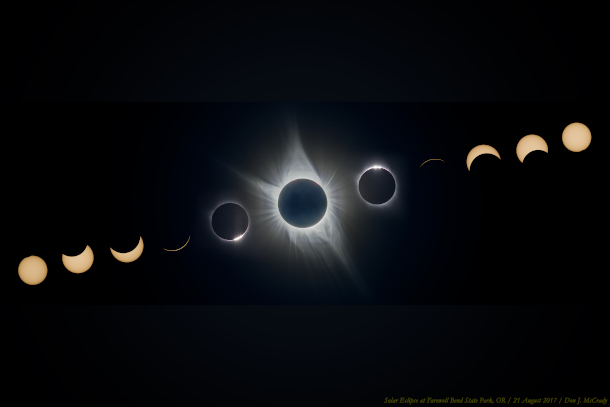
The 2017 total solar eclipse, shown in various stages before and after totality. (Photo: Don McCrady, Flickr, CC BY NC ND 2.0)
DOERING: Thank you. What you're describing sounds like such a profound experience.
TROTTA: It was, it was profoundly moving and primordial in a way that I did not expect. As a scientist, I knew exactly what I was witnessing but in the moment it is as if rationality almost flies out of the window. This black hole in the sky really feels so unnatural, so unlike anything I've ever witnessed before. And when you're actually in the moon shadow you feel, you know, transported into different time, into a different way of being almost. And all of these legends and myth, all of this ancestral fear of eclipses grips you again. So it's wonderful and terrifying at the same time.
DOERING: And it's sort of a coincidence, I understand it and you write in your book that, you know, we happen to be able to see total solar eclipses and it may not always be that way on the earth when we look really far into the future. So what is this coincidence that you write about?
TROTTA: Indeed, it's a strange cosmic coincidence that makes it so that while the sun is much bigger than the moon, it is also so much further away. In fact, about 400 times as further away as the moon, but the moon is almost exactly 400 times smaller than the sun. And so when they line up just right, the moon covers the sun fully and we're treated to this wonderful phenomenon, this total solar eclipse but this will not always be so because the moon is receding, is moving away from the Earth. And so there will be a day in a few hundreds of millions of years, where the moon will have moved further away than it is now and sufficiently so that the disk of the moon will not cover the disk of the sun anymore and total solar eclipses will become impossible. So we've got only a few 100 million years left to witness this amazing cosmic phenomenon before it's too late.
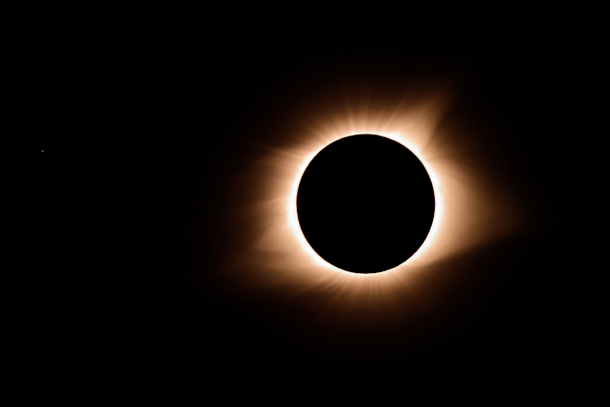
2017’s solar eclipse, photographed with the corona at the moment of totality. (Photo: Geoff Livingston, Flickr, CC BY-NC-ND 2.0)
DOERING: Well, we're lucky to be at this time in history when we can experience it and total solar eclipses have been occurring at least as long as humans have existed. How have past civilizations reacted to these phenomena?
TROTTA: In the past total solar eclipses were so feared because they were mostly impossible to predict and so the reaction was one of great terror. And oftentimes in past civilizations, people would engage in rituals and chants and dances in order to scare away whatever they thought was trying to eat up the sun or destroy the sun. Some civilizations saw dragons or monsters, trying to eat the sun from sky. Some others, like the Aztecs, for example, would throw fiery arrows towards the sun in an attempt to give it back it’s lifeforce and its fire to fight off this cosmic enemy. And so in general, people were absolutely scared to their death by this event, and they attempted everything they could rituals, magic prayers, invocation in order to get the life force of the sun back into its rightful place.
DOERING: And I think in your book, you talk about how this influenced who was in charge who was ruling at various times. Can you describe some of that for us?
TROTTA: Absolutely. Many of the kings and emperors of the past claim that their power was divinely inspired and oftentimes descended directly from a deity that was identified on the sun. There was, for example, the case for the pharaohs in Egypt and others even Louis XIV in France was named the "Sun King" for a reason because he felt that he was the representative of the force of the sun on earth, even in historical times. But perhaps no other civilization was more attentive to ward off the dangers that the disappearance of the sun could bring about for the empire than the Assyrians. And the Assyrians who lived in Mesopotamia over 3,000 years ago, they had a very special way of seeing off this cosmic danger to their king, because of course, when the sun disappeared from sky that was seen as ominous, as a bad omen for the king. And so what the Assyrians did when the solar eclipse was if not expected, but the least possible, they were able to predict when the solar eclipse could potentially happen even though they could not exactly predict when that would for certain happen. So when the solar eclipse was possible, they would instate enthrone, a substitute king, a puppet of sorts. Somebody taken from the populace or perhaps a prisoner, somebody who for a period of time become in all effects the king and they would swear a special oath that they will take upon themselves all the terrestrial and celestial portents in order to see off danger. And once the solar eclipse had passed and the substitute king was no longer needed, he will be executed and the old king re-instated. So in that respect, one could say that the solar eclipse was always a bad omen for the substitute king.

Roberto Trotta is a cosmologist at the International School for Advanced Studies (SISSA) in Trieste, Italy, where he is a Professor of Theoretical Physics and the head of the newly established group in Theoretical and Scientific Data Science. He’s also a Visiting Professor of Astrostatistics at Imperial College London and author of “STARBORN: How the Stars Made Us—and Who We Would Be Without Them”. (Photo: Courtesy of Roberto Trotta)
DOERING: Yeah and that's so great to be that person who's instated it, even though it sounds great, right, instated as king for a while, doesn't end well.
TROTTA: No, no, it always ended badly for the substitute king.
DOERING: So humans have noticed and been awed by solar eclipses for thousands of years but more recently, how has science benefited from studying them?
TROTTA: Solar eclipses have been really important for many reasons but particularly because at the beginning of the 20th century a famous solar eclipse, the one in 1919, allowed astronomer Arthur Eddington to prove Albert Einstein right. Einstein had famously predicted using this newly discovered theory of general relativity, that the position of stars around the sun would appear shifted with respect to their usual position by the bending of space time. And he made a very specific prediction of the amount of bending the angle of displacement of the stars around the sun. But of course, that was impossible to measure during the day, because we don't see stars during the day around the sun so you need a solar eclipse. And when the solar eclipse in 1919, came around, Eddington and others sailed from the United Kingdom to various places in the world to measure the prediction that Einstein had made and they found him correct. And so that essentially propelled Einstein overnight into scientific stardom. So that was one of the ways in which solar eclipses have been used by science to test the fundamental nature of space time.
DOERING: Now, Roberto, we heard that passage from you. And I understand that you and your family were dead set on getting to that total solar eclipse a few years back. It was kind of a struggle, you were carrying a baby hiking up a hill to get to the perfect spot. Why was it so important to you as a cosmologist and as a human to witness a total solar eclipse?
TROTTA: Yes, it was a bit of a struggle and we travel thousands of miles and we, you know, we hired an RV to get to the perfect spot and then we hiked up that hill and in the end, we managed. It was all worth it because, you know, I never seen one before. I tried to see a total solar eclipse in 1999, in southern Germany but the sky had been clouded and it hadn't been success. I didn't feel much, it wasn't really impressive. And I kept hearing about all of these life changing experiences people were having experiencing a total solar eclipse. And to me, it was really important to have that experience the lived experience of the solar eclipse partially because I wanted to reconnect to what the sky meant for our ancestors. We talked earlier about how solar eclipses were really terrifying for people in the past. And I want you to understand how that cosmic connection of ours which is nowadays, largely lost, we experienced the sky through screens, most of the time, we look at pictures of the sky, which are wonderful, wonderful opportunities but we've lost the lived connection and I wanted to recapture some of that. And it was very important to me to do it with my family with my, my wife and my two young children because I felt this was a almost unique life time experience to have had that connection and to stand in the shadow of the moon and to feel what you feel is not just the shadows, also the cold air swirling around, the color changing, nature changing around you. It's a special moment, it's a special moment.
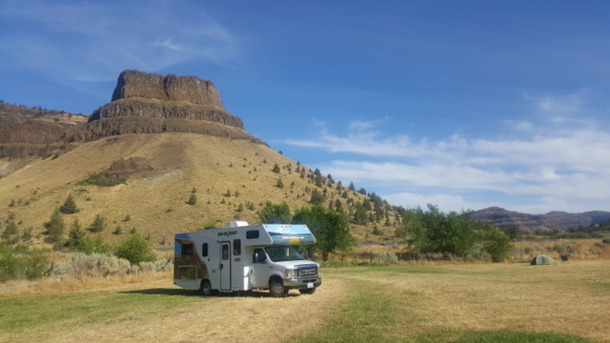
The RV Roberto Trotta’s family traveled in to reach Oregon and experience “the Great American Eclipse of 2017”. (Photo: Roberto Trotta)
DOERING: So that experience for you was back in 2017, which was when what was called "the Great American Eclipse" came to North America because I believe it went coast to coast, it covered much of the US and now there's another total solar eclipse coming up on April 8th that will cross much of Northern America. What recommendations do you have for people who want to view this eclipse?
TROTTA: Yes, this eclipse is going to be spectacular. And if you are close to the center of the path of totality you will be able to experience it for up to 4 minutes 30 seconds almost, which is far longer than I have experienced it. So that's a far longer lasting eclipse if you're in the right place. And so my top recommendation is try and get as close as you can to the central line of the path of totality, because that's where the experience will be the best and will last the longest. It's very, very important that you are within the path of totality, which is the region where the sun is completely covered by the disk of the moon. If you're even a little bit outside, even if the disk of the Sun is 99% covered, which seems like a lot, you're gonna miss out it's not going to be the same experience at all. There's still going to be enough light to ruin the best of the show. You won't be able to see the corona which is the flaring rings of fire if you like around the sun, you won't be able to see stars during the day which is incredible. And you won't get the full change of colors around you as the shadow of the moon travels over you at over 2,000 miles per hour, you won't get any of that. It will still be spectacular but really if you can make the effort of going the extra mile and get yourself inside because inside the actual shadow all of those things happen. The equally important piece of advice is never ever, ever look at the sun directly before it's covered by the moon without special eclipse glasses because your eyesight will be damaged very, very quickly if you try and do that. So never look directly at the sun until totality occurs until it's completely eclipsed by the moon. At which point rip off those glasses because the real spectacle is then you know with your naked eye, and the glasses are not only not needed, they are in the way. So take them off and look at this amazing spectacle while it lasts.
DOERING: Wow, okay. I will remember that for sure. Do not look directly at the sun until you're sure that it's completely covered. And this corona of the sun that you mentioned, so that must be safe to look at with your naked eye?
TROTTA: Yes, yes, once the sun is fully covered, then yes, and indeed that that's one of the most incredible sights because it's this flaring of rays all around the sun which extend quite a bit outside the sun. They're always there, we can't see them usually, because the light itself on the sun covers it up so we don't say under normal conditions. But this is the hotter part of the solar atmosphere flaring out. And it's very spectacular because there's this amazing contrast between the pitch blackness of the disk of the moon in the center, and the brilliant white of the corona, which is entirely safe to look at with your naked eyes. And that's something you really want to witness also look around, look at the stars you see in the sky, if there's any planets visible, they will show up as well. It's really amazing.
DOERING: Wow, I can't wait! So a total solar eclipse can last from just 10 seconds to around seven minutes and that sounds like a really short time for an event that happens only every 100 years or so from a given location.
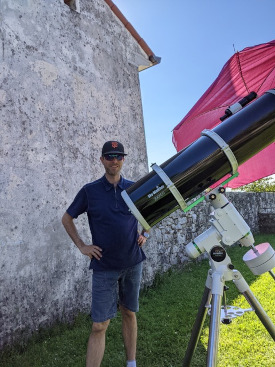
Roberto Trotta with his telescope in his home in Italy. (Photo: Roberto Trotta)
TROTTA: But it's not actually my eclipse, the one that I witness only lasted a minute, fifty eight seconds. And that sounds even less certainly it is less than the one that's coming up, which will last up to 4 minutes and 27 seconds. But it's actually quite a long time because while you're in the shadow time plays tricks on you, time stretches, the flow is almost stopped and it feels like you're almost entering a different flow of time. So I experienced it for less than 3 minutes and felt much longer timeframe actually. So to experience it for anything around 4 minutes this time must be incredible because you know, when you look at this black hole in the sky and you start wondering- will it ever move on, will it ever give us back the sun? And it gets cold quite quickly as well, you know, the temperature drops quite sensibly while you are in the shadow. It's really an experience that changes your perception of time. So no, 4 minutes is plenty to enjoy it and to get really wonderful sense of what it feels like.
DOERING: Sounds like one of those experiences where all of your senses can be heightened and you can just feel really purely in that moment.
TROTTA: Yes, and my piece of advice is don't get obsessed with capturing the clips with your phone with your camera. Because the reality is there's plenty of great pictures of the eclipse everywhere online, you can download any number of them and chances are they're going to be better than yours. But your multi sensorial experience is not just the site there's also if you're in nature, you will hear nature, calm down, its the sensation of the shadow of the moon being cold. All of this you cannot capture on your camera. If you're fiddling with your phone, you're fiddling with your camera most of the time to try to capture the actual eclipse you're going to miss out on actually experiencing what is going on all around you. So my advice is to focus to be in the moment. So try to savor it and do not try to live it through screens because you will be missing some of the experience.
DOERING: Roberto Trotta is a cosmologist and author of “Starborn: How the Stars Made Us (And Who We Would Be Without Them)”. Thank you so much Roberto.
TROTTA: Thank you it's been a huge pleasure being with you.
Links
Learn more about the 2024 total solar eclipse
Try to get as close to the 2024 by tracking the path of totality
Learn more about professor of Astrophysics and Data Science Roberto Trotta
Living on Earth wants to hear from you!
Living on Earth
62 Calef Highway, Suite 212
Lee, NH 03861
Telephone: 617-287-4121
E-mail: comments@loe.org
Newsletter [Click here]
Donate to Living on Earth!
Living on Earth is an independent media program and relies entirely on contributions from listeners and institutions supporting public service. Please donate now to preserve an independent environmental voice.
NewsletterLiving on Earth offers a weekly delivery of the show's rundown to your mailbox. Sign up for our newsletter today!
 Sailors For The Sea: Be the change you want to sea.
Sailors For The Sea: Be the change you want to sea.
 The Grantham Foundation for the Protection of the Environment: Committed to protecting and improving the health of the global environment.
The Grantham Foundation for the Protection of the Environment: Committed to protecting and improving the health of the global environment.
 Contribute to Living on Earth and receive, as our gift to you, an archival print of one of Mark Seth Lender's extraordinary wildlife photographs. Follow the link to see Mark's current collection of photographs.
Contribute to Living on Earth and receive, as our gift to you, an archival print of one of Mark Seth Lender's extraordinary wildlife photographs. Follow the link to see Mark's current collection of photographs.
 Buy a signed copy of Mark Seth Lender's book Smeagull the Seagull & support Living on Earth
Buy a signed copy of Mark Seth Lender's book Smeagull the Seagull & support Living on Earth

